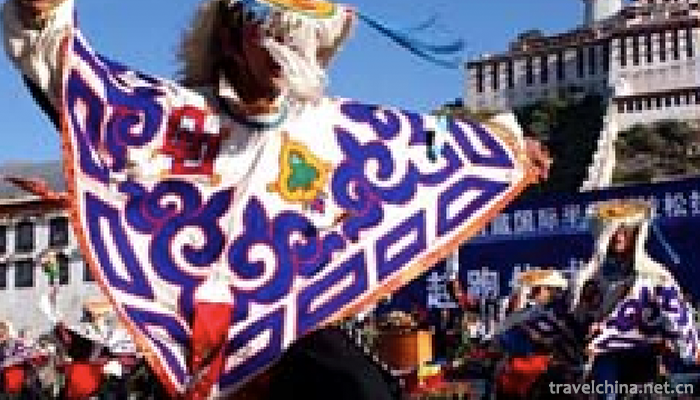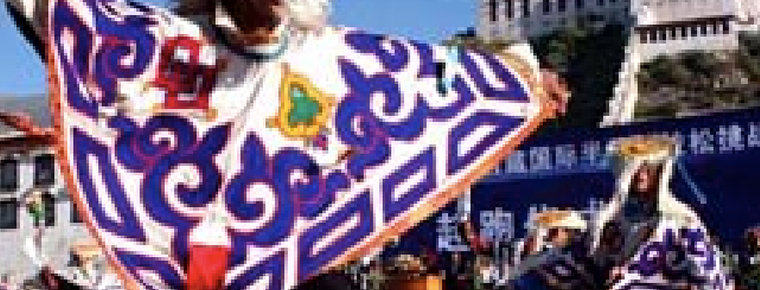Harmonic Qin
Harmonic Qin
In the history of Harmonious Qin, young men and women in Nima Township, Bango County, Naqu Prefecture, Tibet had a tradition of gathering to dance Harmonious Qin. Whether it was the end of farming or the holidays, herdsmen danced freely on the vast grasslands and let their boots strike echoes on the ground. It is a masterpiece of the fifth Panchen Chan in his childhood. Its performance forms are very rich. It uses various body languages and singing tunes to express the actions of sheep when they eat grass. It also compares them to beautiful things in life, such as flowers, plants and trees. It makes the dull sheep herding life lively, lively and interesting.
On June 7, 2008, Xieqin was listed in the second batch of national intangible cultural heritage list with the approval of the State Council.
Historical Evolution
Tubu Gatschin originated in 1855 , and was founded by the eighth Panchen Dan Beiwangqiu. It has a history of more than 150 years. Tubu Jiaqin is a combination of singing and dancing. "Harmony" in Tibetan means singing and dancing, while "Qin" means grand occasion or grandeur. Tubu Jiaqin is a folk song and dance performed on grand or grand celebration occasions, such as inviting living Buddhas and upper classes. Whether religious festivals or folk festivals, Harmonious Qin is an indispensable form of activity, and also a self-entertaining collective singing and dancing art with strong participation.
Tibetan culture and art has a long history. The vast territory, abundant resources and peculiar scenery of Shiga are a treasure land bred on the ancient and magnificent plateau land. Since ancient times, it has been a place where ethnic minorities live in large numbers. It has a rich accumulation of ethnic cultures because of the collision and blending of various cultures. The Xigaze area can be said to be the origin of Xiqin. Tubu Jiaqin was born and formed in the long-standing folk dances in the back Tibet area. With the wide spread of Tibetan Buddhist culture, Tubu Jiaqin inherited the form of local folk singing and dancing art, and was deeply influenced by multi-cultures, and produced variations. Tubugaqin originated in 1855 and was founded by the eighth Panchen Danbeiwangqiu. It is a kind of folk ceremonial dance with the accompaniment of the original singing, which is popular in Nanmulin County of Shigaze area.
Stylistic features
Singing and Dancing Situation
Ancient ritual forms of singing and dancing, which are popular in Lhasa, Shannan and Ali of Tibet, are often sung during grand festivals or ceremonies. The first and last songs are called "Harmonious Fruit" (introduction) and "Zhaxi" (auspicious). Each song and dance is composed of Adagio and adagio, or adagio, mid-board and adagio. The music is simple and enthusiastic. The lyrics include the origin of human beings, historical legends, praises and blessings, etc.
Performing Form
Harmonious Qin is an art form of singing and dancing performed in grand or grand celebrations. It has a long history, rich connotation, and strong local characteristics. This form of performance is very popular in Tibet, especially in Houzang. In the long process of inheritance and development, it has formed a singing and dancing performing art with unique local characteristics.
Inheritance Significance
Xieqin, also known as Xiejiuqin (meaning the tenth day of the Tibetan calendar), is said to have 25 lyrics written by the eighth Panchen Danbeiwangqiu. Tubugaqin was a kind of folk dance performed by Panchen Chan in the past dynasties when they went to Zhashlenbu Monastery in Xidi to hold grand greeting activities along the way. It is performed at a ceremonial event at a given time and place to wish good luck, good wishes, good weather and good harvest. It has unique local characteristics and performance style, rich lyrics, simple and honest melody, warm and orderly rhythm, and solemn and elegant performance form.


-
1.Taimu Mountains
Taimu Mountain is located in the northeast of Fujian Province. It is 45 kilometers south of Fuding City from the urban area.
Time 2018-12-08 -
2.Huanghelou Park Wuhan
Wuhan Yellow Crane Tower Park: The Yellow Crane Tower on Snake Mountain in Wuchang is one of the three famous buildings in the south of the Yangtze River.
Time 2018-12-12 -
3.Oriental Giant Turtle Garden
Located on the East Bank of Yehe River in Pingshan County, Hebei Province, the Oriental Giant Turtle Garden is near Xibaipo, a sacred revolutionary site, 35 kilometers east of Shijiazhuang
Time 2018-12-20 -
4.Eco health Tourism Resort in Sishui Shandong Province
"Shandong Sishui Violent Eco-health Tourism Resort" is a pioneer in China, which combines superior ecological environment, long-standing health culture and modern leisure and vacation indust
Time 2019-02-13 -
5.Subashi Buddhist Temple Site
Subashi Buddhist Temple Site , also known as Zhaohuili Temple, is located in the south foot of the Queletag Mountains in the northeast of Kuqa County, Xinjiang. It is a national key
Time 2019-02-13 -
6.Taishan Hot Spring City
Taishan Hot Spring City Cultural Tourism Scenic Spot is invested and constructed by Shandong Taishan Hot Spring Tourism Development Co., Ltd. with a total investment of 2.6 billion yuan
Time 2019-02-13 -
7.Legend of Yellow Crane Tower
The legend of the Yellow Crane Tower has a long history, and has been accompanied by the repeated destruction and construction of the Yellow Crane Tower
Time 2019-05-04 -
8.Making Techniques of Pickled Vegetables
Making pickles, the traditional skills of Beijing Liubiju Food Co., Ltd., is one of the national intangible cultural heritage.
Time 2019-05-06 -
9.Yongxin Drum
Yongxin Xiaogu is one of the traditional operas in Ji'an City, Jiangxi Province, which originated from Taoism. Legend has it that it was formed in Yongxin, Jiangxi Province during the reign of Qingdao
Time 2019-07-14 -
10.An Zhongrong
An Zhongrong (- 942 years), Zi tie Hu, Shuozhou (now Shuozhou, Shanxi). The generals of the Five Dynasties and Ten Kingdoms during the late Tang Dynasty and the Late Jin Dynasty.
Time 2019-09-11 -
11.Geographical environment of Mianyang
Mianyang City is located in the northwest of Sichuan Basin, in the middle and upper reaches of Fujiang River, bordering Qingchuan county and Jiange County of Guangyuan City in the East, Shehong city and Daying County in Suining City in the south, Luojiang
Time 2020-12-14 -
12.Mianyang Tourism
In 2018, Mianyang City realized a total tourism revenue of 64.766 billion yuan, an increase of 21.5%. Among them, domestic tourism revenue was 64.740 billion yuan, an increase of 21.4%; foreign exchange income of tourism was 3.8889 million US dollars,
Time 2020-12-14